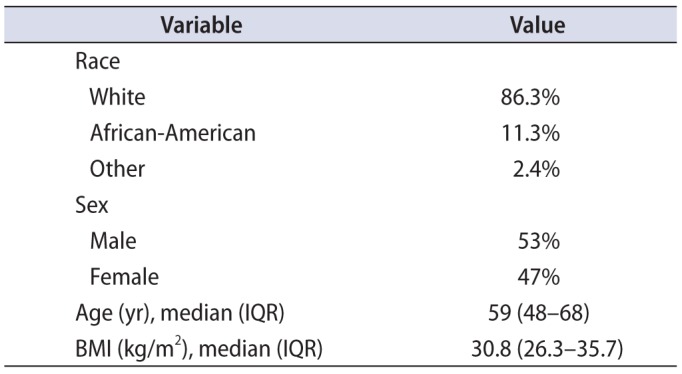1. De SK, Liu X, Monga M. Changing trends in the American diet and the rising prevalence of kidney stones. Urology. 2014; 84:1030–1033. PMID:
25201150.

2. Scales CD Jr, Smith AC, Hanley JM, Saigal CS. Urologic Diseases in America Project. Prevalence of kidney stones in the United States. Eur Urol. 2012; 62:160–165. PMID:
22498635.

3. Curhan GC, Willett WC, Knight EL, Stampfer MJ. Dietary factors and the risk of incident kidney stones in younger women: Nurses' Health Study II. Arch Intern Med. 2004; 164:885–891. PMID:
15111375.
4. Curhan GC, Willett WC, Rimm EB, Stampfer MJ. A prospective study of dietary calcium and other nutrients and the risk of symptomatic kidney stones. N Engl J Med. 1993; 328:833–838. PMID:
8441427.

5. Delvecchio FC, Preminger GM. Medical management of stone disease. Curr Opin Urol. 2003; 13:229–233. PMID:
12692447.

6. Fellstrom B, Danielson BG, Karlstrom B, Lithell H, Ljunghall S, Vessby B. Dietary habits in renal stone patients compared with healthy subjects. Br J Urol. 1989; 63:575–580. PMID:
2752249.
7. Parivar F, Low RK, Stoller ML. The influence of diet on urinary stone disease. J Urol. 1996; 155:432–440. PMID:
8558629.

8. Siener R. Impact of dietary habits on stone incidence. Urol Res. 2006; 34:131–133. PMID:
16404621.

9. Wertheim ML, Nakada SY, Penniston KL. Current practice patterns of urologists providing nutrition recommendations to patients with kidney stones. J Endourol. 2014; 28:1127–1131. PMID:
24846196.

10. Baer HJ, Blum RE, Rockett HR, Leppert J, Gardner JD, Suitor CW, et al. Use of a food frequency questionnaire in American Indian and Caucasian pregnant women: a validation study. BMC Public Health. 2005; 5:135. PMID:
16356183.

11. Blum RE, Wei EK, Rockett HR, Langeliers JD, Leppert J, Gardner JD, et al. Validation of a food frequency questionnaire in Native American and Caucasian children 1 to 5 years of age. Matern Child Health J. 1999; 3:167–172. PMID:
10746756.
12. Rockett HR, Breitenbach M, Frazier AL, Witschi J, Wolf AM, Field AE, et al. Validation of a youth/adolescent food frequency questionnaire. Prev Med. 1997; 26:808–816. PMID:
9388792.

13. Wei EK, Gardner J, Field AE, Rosner BA, Colditz GA, Suitor CW. Validity of a food frequency questionnaire in assessing nutrient intakes of low-income pregnant women. Matern Child Health J. 1999; 3:241–246. PMID:
10791365.
14. Ljunghall S, Danielson BG. A prospective study of renal stone recurrences. Br J Urol. 1984; 56:122–124. PMID:
6498430.

15. Pearle MS, Calhoun EA, Curhan GC. Urologic Diseases of America Project. Urologic diseases in America project: urolithiasis. J Urol. 2005; 173:848–857. PMID:
15711292.

16. Penniston KL, Nakada SY. Diet and alternative therapies in the management of stone disease. Urol Clin North Am. 2013; 40:31–46. PMID:
23177633.

17. Kubena KS. Accuracy in dietary assessment: on the road to good science. J Am Diet Assoc. 2000; 100:775–776. PMID:
10916514.
18. Hunt DL, Haynes RB, Hanna SE, Smith K. Effects of computer-based clinical decision support systems on physician performance and patient outcomes: a systematic review. JAMA. 1998; 280:1339–1346. PMID:
9794315.
19. Garg AX, Adhikari NK, McDonald H, Rosas-Arellano MP, Devereaux PJ, Beyene J, et al. Effects of computerized clinical decision support systems on practitioner performance and patient outcomes: a systematic review. JAMA. 2005; 293:1223–1238. PMID:
15755945.
20. Kaushal R, Shojania KG, Bates DW. Effects of computerized physician order entry and clinical decision support systems on medication safety: a systematic review. Arch Intern Med. 2003; 163:1409–1416. PMID:
12824090.
21. Kawamoto K, Houlihan CA, Balas EA, Lobach DF. Improving clinical practice using clinical decision support systems: a systematic review of trials to identify features critical to success. BMJ. 2005; 330:765. PMID:
15767266.

22. Afzal M, Hussain M, Ali T, Hussain J, Khan WA, Lee S, et al. Knowledge-based query construction using the CDSS knowledge base for efficient evidence retrieval. Sensors (Basel). 2015; 15:21294–21314. PMID:
26343669.

23. Trinchieri A. Development of a rapid food screener to assess the potential renal acid load of diet in renal stone formers (LAKE score). Arch Ital Urol Androl. 2012; 84:36–38. PMID:
22649959.
24. Trinchieri A. A rapid food screener ranks potential renal acid load of renal stone formers similarly to a diet history questionnaire. Urolithiasis. 2013; 41:3–7. PMID:
23532416.








 PDF
PDF ePub
ePub Citation
Citation Print
Print





 XML Download
XML Download